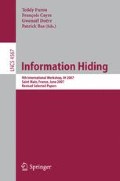Abstract
This paper analyses the security of dirty paper trellis (DPT) watermarking schemes which use both informed coding and informed embedding. After recalling the principles of message embedding with DPT watermarking, the secret parameters of the scheme are highlighted. The security weaknesses of DPT watermarking are then presented: in the watermarked contents only attack (WOA) setup, the watermarked data-set exhibits clusters corresponding to the different patterns attached to the arcs of the trellis. The K-means clustering algorithm is used to estimate these patterns and a co-occurrence analysis is performed to retrieve the connectivity of the trellis. Experimental results demonstrate that it is possible to accurately estimate the trellis configuration, which enables to perform attacks much more efficient than simple additive white Gaussian noise (AWGN).
Access this chapter
Tax calculation will be finalised at checkout
Purchases are for personal use only
Preview
Unable to display preview. Download preview PDF.
References
Comesaña, P., Pérez-Freire, L., Pérez-González, F.: Fundamentals of data hiding security and their application to spread-spectrum analysis. In: Barni, M., Herrera-Joancomartí, J., Katzenbeisser, S., Pérez-González, F. (eds.) IH 2005. LNCS, vol. 3727, Springer, Heidelberg (2005)
Cayre, F., Fontaine, C., Furon, T.: Watermarking security part I: Theory. In: Proceedings of SPIE, Security, Steganography and Watermarking of Multimedia Contents VII, San Jose, USA, vol. 5681 (2005)
Pérez-Freire, L., Pérez-González, F., Furon, T.: On achievable security levels for lattice data hiding in the Known Message Attack scenario. In: 8th ACM Multimedia and Security Workshop, Geneva, Switzerland, pp. 68–79 (accepted)
Doërr, G., Dugelay, J.L.: Security pitfalls of frame-by-frame approaches to video watermarking. IEEE Transactions on Signal Processing (formerly IEEE Transactions on Acoustics, Speech, and Signal Processing) 52 (2004)
Cayre, F., Fontaine, C., Furon, T.: Watermarking security part II: Practice. In: Proceedings of SPIE, Security, Steganography and Watermarking of Multimedia Contents VII, San Jose, USA, vol. 5681 (2005)
Bas, P., Hurri, J.: Vulnerability of dm watermarking of non-iid host signals to attacks utilising the statistics of independent components. IEE proceeding, transaction on information security 153, 127–139 (2006)
Miller, M.L., Doërr, G.J., Cox, I.J.: Applying informed coding and embedding to design a robust, high capacity watermark. IEEE Trans. on Image Processing 6(13), 791–807 (2004)
Costa, M.H.M.: Writing on dirty paper. IEEE Transactions on Information Theory 29(3), 439 (1983)
Viterbi, A.J.: CDMA: Principles of Spread Spectrum Communication. Addison-Wesley, Reading, pub-AW:adr (1995)
Koval, O., Voloshynovskiy, S., Deguillaume, F., Pérez-González, F., Pun, T.: Worst case additive attack against quantization-based data-hiding methods. In: Proceedings of SPIE, Security, Steganography and Watermarking of Multimedia Contents VII, San Jose, USA (2005)
MacQueen, J.: Some methods for classification and analysis of multivariate observations. In: LeCam, L.M., Neyman, J. (eds.) Proc. of the 5th Berkeley Symp. on Mathematics Statistics and Probability (1967)
He, J., Lan, M., Tan, C.L., Sung, S.Y., Low, H.B.: Initialization of cluster refinement algorithms: a review and comparative study. In: Proceedings of IEEE International Joint Conference on Neural Networks, pp. 25–29 (2004)
Kohonen, T.: Improved versions of learning vector quantization. In: IJCNN 1990, pp. 545–550 (1990)
Wang, C., Doërr, G., Cox, I.J.: Trellis coded modulation to improve dirty paper trellis watermarking. In: Proc. SPIE (2007)
Ward Jr., J.H.: Hierarchical grouping to optimize an objective function. Journal of the American Statistical Association 58, 236–244 (1963)
Bas, P., Cayre, F.: Achieving subspace or key security for woa using natural or circular watermarking. In: ACM Multimedia and Security Workshop, Geneva, Switzerland (2006)
Author information
Authors and Affiliations
Editor information
Editors and Affiliations
Rights and permissions
Copyright information
© 2007 Springer-Verlag Berlin Heidelberg
About this paper
Cite this paper
Bas, P., Doërr, G. (2007). Practical Security Analysis of Dirty Paper Trellis Watermarking. In: Furon, T., Cayre, F., Doërr, G., Bas, P. (eds) Information Hiding. IH 2007. Lecture Notes in Computer Science, vol 4567. Springer, Berlin, Heidelberg. https://doi.org/10.1007/978-3-540-77370-2_12
Download citation
DOI: https://doi.org/10.1007/978-3-540-77370-2_12
Publisher Name: Springer, Berlin, Heidelberg
Print ISBN: 978-3-540-77369-6
Online ISBN: 978-3-540-77370-2
eBook Packages: Computer ScienceComputer Science (R0)

